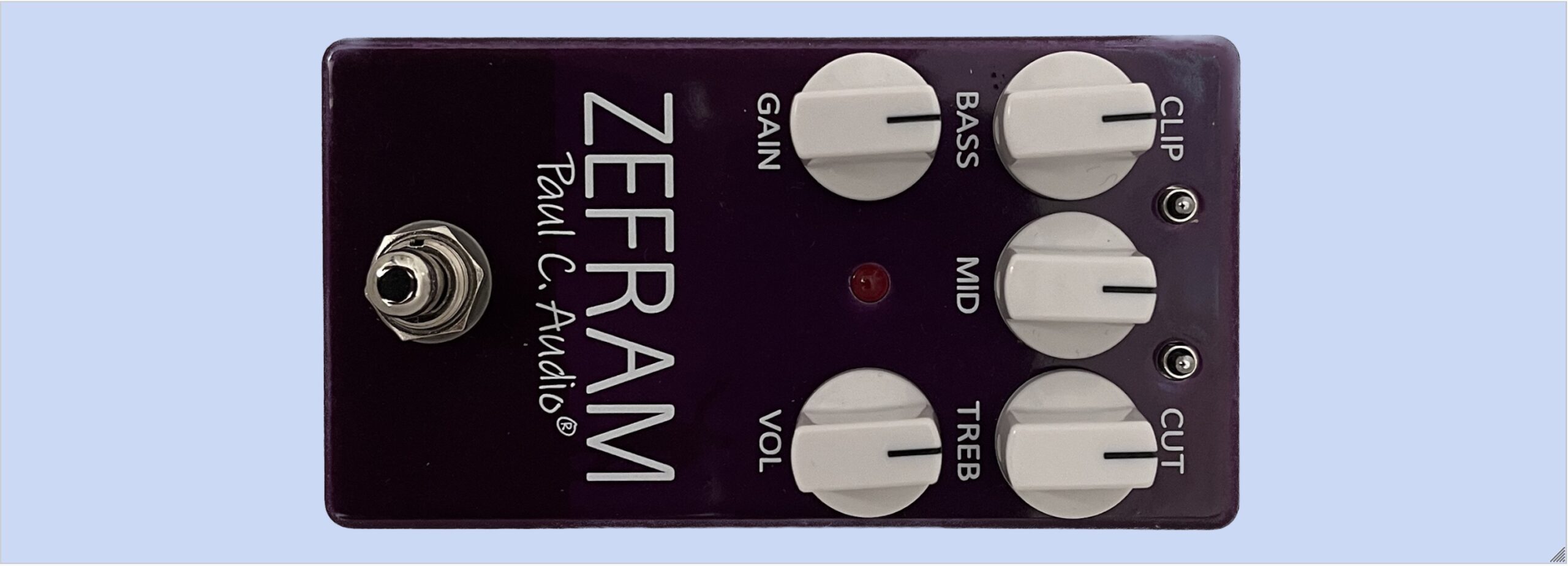
By Ian Waters
Posted 09/20/2024
Introduction
Paul Chochrane’s name has become something of a staple in the community of pedal builders and discerning players from the Tim/Timmy lines over the past two decades. The reason is that the pedals have become widely influential in the ever bourgeoning market for boutique builders who have looked to the Tim as the standard in “transparent” overdrive and distortion. With the Zefram, Mr. Cochrane seems less interested in carrying on the tradition of transparency and is taking aim at creating a sonic platform that offers much more character and range, not that the Zefram doesn’t employ some of the highly musical and useable transparency. It offers a lovely sounding edge-of-breakup tone that allows the player to control the amount of harmonics and compression from the volume knob and pick attack. But the Zefram goes further into tube screaming or Klon territory and into near high gain distortion, with as much control of low end and mid as the player could want.
Paul Cochrane’s Zefram is the perfect bridge from the transparent boost and light gain of the Timmy, to the honk and cut of a mid focused drive, all the way to near RAT-like glory with its intuitive three stage clipping circuit, active bass and mid controls, and post op amp treble control and a cut-switch. We ran the Zefram through its paces using a Les Paul, a Stratocaster, and a Telecaster into a silverface Fender amp. The pedal doesn’t offer quite as much edge of breakup as Cochrane’s venerable Tim series, but does mid to high gain and the dirty mid range quite well. It could be completely suitable as the only gain stage in a signal chain. The Zefram is a great option for a working guitarist who wants to add a highly tweak-able color to the gain staging pallet for solos, heavy lead riffs, and low gain playing.
Zefram Layout & Design
Like the other pedals from Paul Cochrane, the Zefram’s build quality speaks for itself. The enclosure is hefty, lightweight, and boosts quality-feeling controls. With a high gloss purple paint job and Timmy-esque white knobs, the design feels intuitive, if not a little top-heavy, having five knobs and two toggle switches. The knobs move smoothly and the pots feel sturdy and control bass, mids, treble, gain, and volume. The bass and mids controls are active, meaning they boost bass and mids past noon on the dial and are before the op amp stage, making their effect on the overall sound quite dramatic. Because of this, achieving the transparency of pedals like the Tim, while achievable, is not the strong suit of the circuit. Instead, the ability to create near fuzz-like sounds by boosting the bass in to the op amp, or into Klon-like territory by boosting the mids, makes this a chameleon of distortion types. The post op amp treble controls act like the filter of a RAT pedal, allowing a cut of treble after the gain staging, along with an EQ switch that can do the same thing more dramatically.
With plenty of volume and enough gain on tap to act as a great boost or solo tool, the Zefram also has three stages of clipping available via toggle switch. The clipping staging is subtle and only feels significant at high gain levels, at which point it goes from high distortion to near high gain levels in slight increments.
Who is the Paul Cochrane Zefram for?
The Zefram is a great option for a guitarist who is looking to add character to their gain staging. It’s a well built, easy to use tone machine capable of getting into a territory largely dominated by mid focused overdrives but has it’s own character. It’s not quite the Klon, the RAT, or the Tube Screamer, but it can be a more grown up version, if you will. While it’s mid-focused brethren are famous, some players find the EQ exaggerations to be to forceful and too obtrusive to their inherent sound. It is precisely for these players that the Zefram is perfect. Mid focusing and bass forwarding are tools that are quite effective at cutting through a mix and creating a tone and character that allows for separation of distinct parts in a mix.
Plenty of players leave their Klon or RAT on as a dirty, ragged sound that they boost with another pedal for solos. The Zefram shines in this way, but uses high quality components that fetch high prices in their alternatives on the used market. With used prices hovering under 200 USD, the Zefram is priced to be an investment that won’t break the bank but won’t leave the user longing for better quality either. The innovative pre op amp mids and bass control allow for gain that has a truly unique character .The Zefram is a great option for a guitarist who’s looking to get dirty and do it with their own style.
